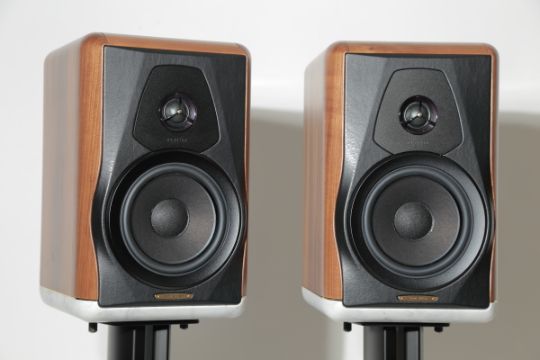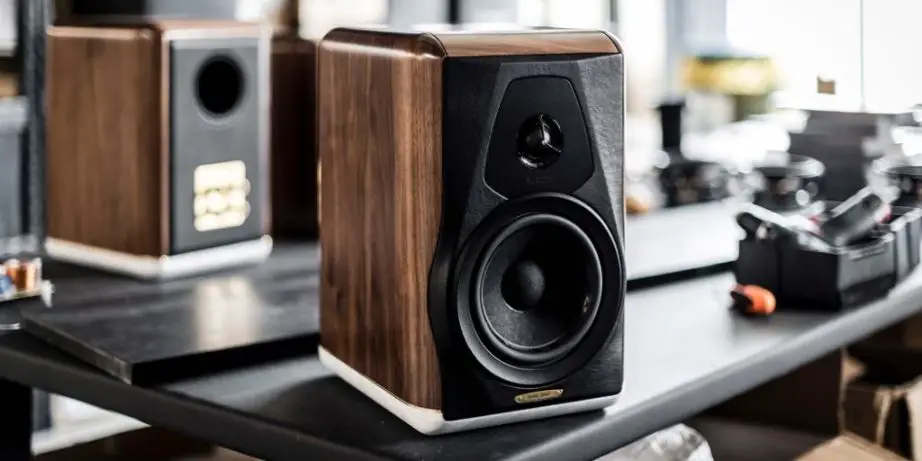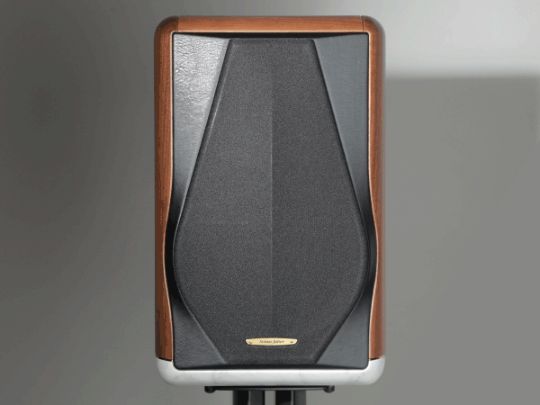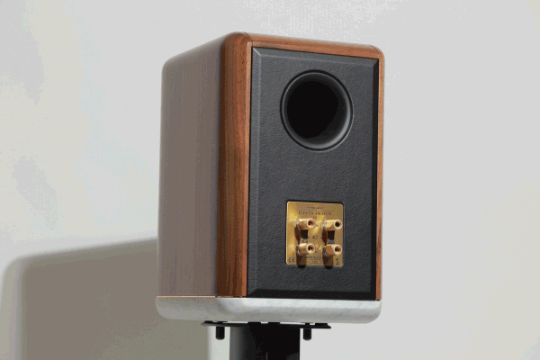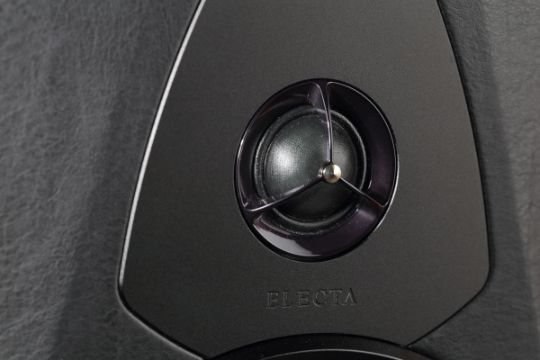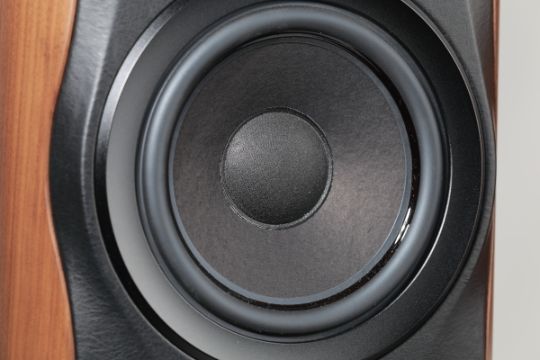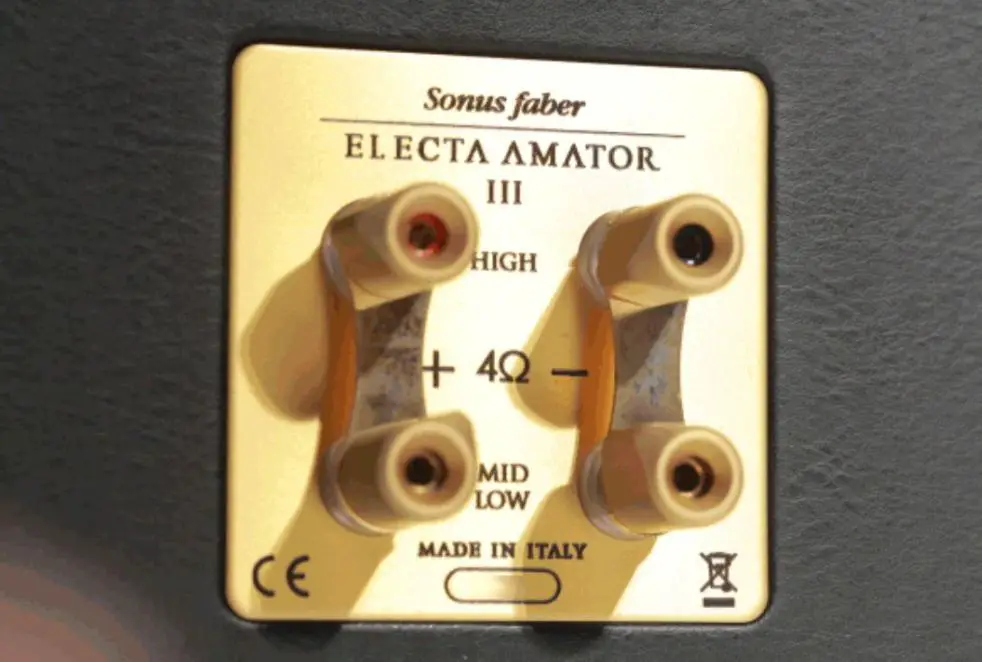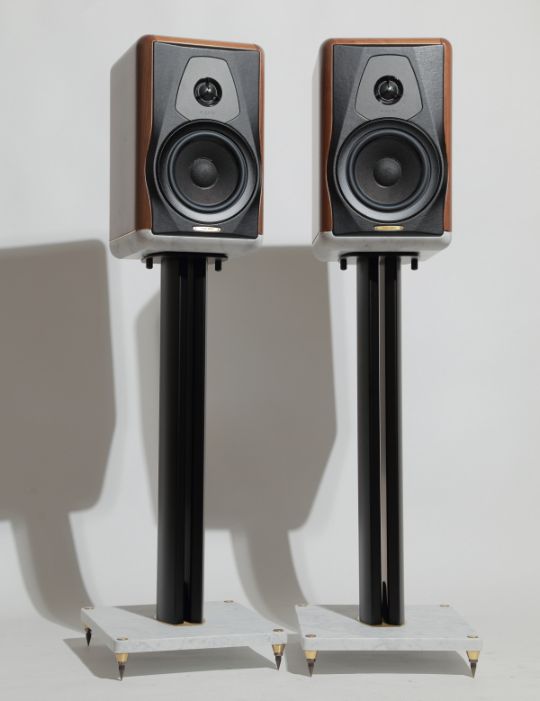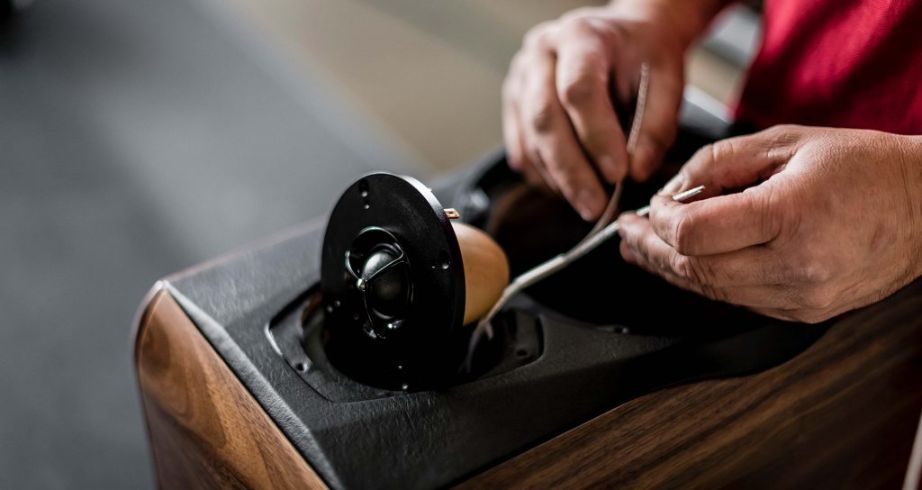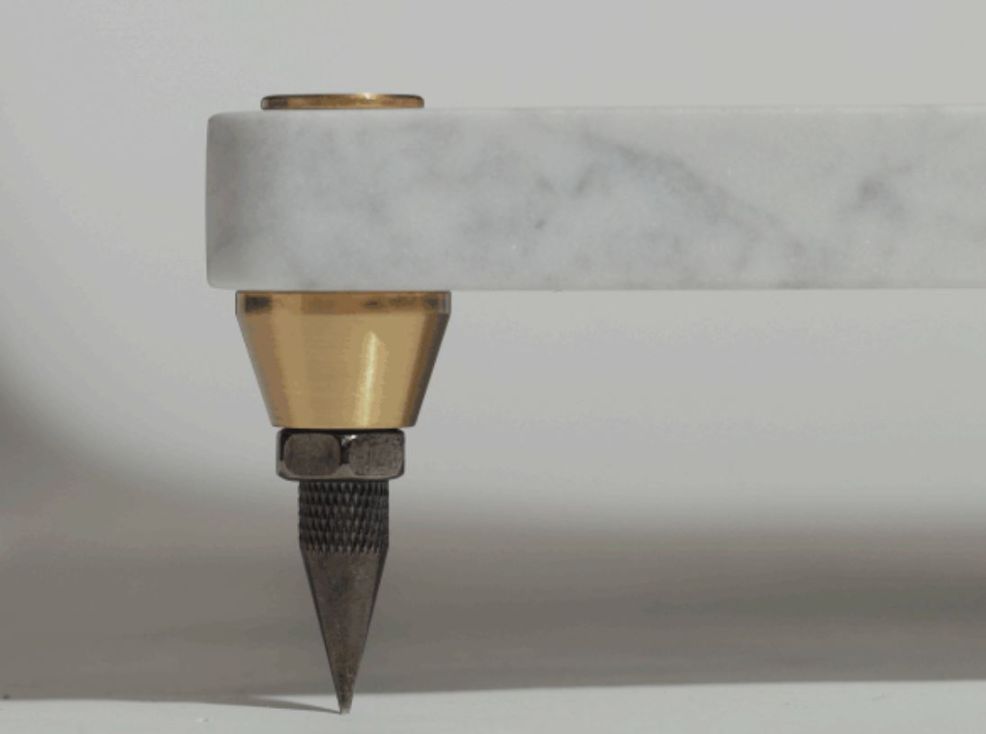Sonus Faber Electa Amator III Review
Electa Amator can be Sonus Faber’s most classic bookshelf speaker before launching the Stradivari series. The first generation of Electa Amator came out in 1987, combining solid wood, leather, and marble, beautiful Italian design elements. It became a classic when it was launched. Ten years later, in 1997, Sonus Faber launched the second-generation Electra Amator II, which is still very popular. However, it was not until the 35th anniversary of the establishment of Sonus Faber in 2019 that Sonus Faber Electa Amator III was launched. Unfortunately, this third-generation was not easy to come by. It took 22 years to wait.
Electa Amator III is a two-tone with bass reflex port design, using a 28mm DAD (Damped Apex DOme) technology unit and a 6.5″ woofer unit with a classic fiber paper cone, specially designed for Electa Amator III.
Design
The box is made of various materials, the body is made of solid walnut, and the base is made of Italian Carrara marble. In addition, the front and rear panels are covered with Italian hand-stitched leather, and the exclusive tripod is also carefully designed.
In the early Sonus Faber, high-end speakers used Dynaudio monomers, and they were the most expensive, like the famous T330. However, Dynaudio later did not sell a single unit, so Sonus Faber developed its tweeter. In 2019, the third-generation Electa Amator III, the tweeter, is a 28mm H28 XTR-04 monomer, maintaining Sonus Faber’s tradition of using silk soft hemispherical tweeters.
The Somus Faber Electa Amator III’s new tweeter is DAD, the abbreviation of Damper Apex Dome, and Dome stands for the silky soft hemispherical tweeter.
Damped is a cavity behind the monomer, using high damping materials to absorb the back wave of the monomer and prevent the back sound waves of the tweeter from being reflected, affecting the sound waves projected forward, causing time and phase errors, and affecting the high-frequency resolution.
Apex is the tripod above the tweeter, with a sharp cone in the center. There is unique tripod support in front of the diaphragm, which enhances the sound wave diffusion, reduces the directivity of the high pitch, makes the sound field sound more open, and the sweet spot wider.
But the mystery of Electa Amator III’s treble is more than that. Looking at the bass reflex hole at the rear, you can see a closed cabinet behind the treble. The independent sound room is made of solid wood, but it doesn’t matter whether it is solid wood or not.
What matters is its function. It seems that Sonus Faber Electa Amator III is a bass reflex speaker, but the treble is sealed independently. So this treble part becomes a sealed speaker. Wilson Audio also likes to use the design of mixing airtight and bass reflex speakers.
What are the benefits of mixing sealed speakers and bass reflex speakers? Get cleaner high frequencies. Bass reflex speakers help enhance the low-frequency volume and extension and can also improve the speaker’s efficiency.
But the airflow noise of the bass reflex hole is itself a source of distortion. The tweeter does not need to strengthen the low frequency. The efficiency of the monomer itself is relatively high. So switching to the sealed design will sacrifice a little work efficiency but can get cleaner high-frequency regeneration, which is complementary to the bass reflex speakers.
The mid-bass monomer used in Electa Amator III is a 6.5-inch monomer specially developed by Sonus Faber for this speaker. The model is MW18XTR-04. Using a paper diaphragm, which is the paper cone used by old speakers, you can feel the retro atmosphere of Electa Amator III from the selection of these materials.
Although the Sonus Faber is not doing “re-engraving” and faithfully recreating the old Electa Amator in the selection of materials, it does not pursue modern composite materials but creates classics.
The classic design elements are still solid wood, leather, and marble, and the processing techniques are more exquisite. For example, the marble of Sonus Faber Electa Amator III was used on the exclusive tripod as a heavy base in the early years. But in Electa Amator III, the marble is used as the speaker bottom plate, and the top uses tenon joints to make solid wood speakers.
When I listen to Electa Amator III, I can’t help but touch the solid wood surface of the speakers and feel the Italian craftsmanship. I took the fine flannel and wiped it back and forth. As a result, the solid wood luster of Electa Amator III will be more beautiful. The longer you use it, the more you wipe it, the more attractive the solid wood speakers are.
Logically speaking, solid wood is not the best material for making speaker cabinets because the growth of trees limits solid wood. In addition, the temperature and humidity change every season, and the internal density is not even. But the density of the MDF or HDF is guaranteed to be average.
On the other hand, the classic style of Sonus Faber is made of solid wood. One is because of the excellent solid wood feel. It also shows the Sonus Faber Master the sound quality of solid wood.
Sonus Faber Electa Amator III also has an exclusive tripod. The design is the same as modern and classic. The base is also marble, but the support frame is replaced by aluminum alloy instead of the solid wood tripod of the early years. The visual effect is quite beautiful when the two are combined.
Of course, in terms of the functionality of the speaker stand, the marble base itself is very heavy and provides a solid foundation for the speaker. At the same time, the aluminum alloy support frame should theoretically be more robust and more durable than wood.
Sound Performance
Listening to Dire Strait’s “Brothers In Arms”, although it does not test the speakers’ performance, the clear treble of Sonus Faber Electa Amator III is not the same as the old Electa Amator. The crisp guitar breaks down the chord playing underlay, with the melody of the guitar solo floating on it, and the underlay has a rich electric guitar sound.
In short, listening to the soft “Why Worry” on Electa Amator III will give you not only a warm and thick mid-range but also a clear and transparent mid-range and high-frequency range. The volume and density of the low-range range are also obviously compared to the old Sonus Faber. Much better.
Audiophiles who like to listen to operas will appreciate the sound quality and timbre of Sonus Faber Electa Amator III. Sonus Faber’s existing warm mid-frequency, coupled with a more open and transparent sound field performance, makes the sound on the opera stage move and appear more lifelike. Listen to the cooperation between Pavolodi and Freni, and Karajan conducts the “Bohemians” of the Berliner Philharmoniker.
“Questo Mar Rosso” at the opening of the first act. The painter Marcello stood on the right side of the stage and sang “Qesto Mar Rosso”, and the writer Rudolph (Pavarroti) came out from the right side of the stage and sang with the painter. The singing gradually moved closer to the center of the stage. Two people sang while performing.
On the Sonus Faber Electa Amator III, in the wide sound field, rich notes emerged. The thickness of the notes is still the fascinating part of Electra Amator III. Although the bandwidth is better than before, Sonus Faber still has its unique charm with the thickness and rich taste of the human voice.
Want to listen to a soprano? Come, switch to “TOCCA” by Caballé. I like the Philips version of Covent Garden Opera Royal Orchestra conducted by Colin Davis, and I listen to the most popular [Vissi D’Arte, Vissi D’Amore]. When Caballé sings Vissi D’Arte, the orchestra only responds with the string club and speaks quietly. The thick voice echoed with the string group that raised the volume and stretched out the sadness, and then the string group slowly fell, as if it could not get a response to the cry of heaven.
Conclusion
Sonus Faber’s excellent products are already the incarnation of beauty, a dreamy boutique among speakers. It is located in Italy and has fully demonstrated the local craftsmanship level. Sonus Faber Electa Amator III has come to the third generation.
In addition to inheriting the glory of the past, it also adds Many of the latest designs and technologies. 2018 is the 35th birthday of Sonus Faber. The birth of Electa Amator III commemorates this important milestone. It is a home desktop speaker suitable for your choice.
Sonus Faber Electa Amator III Specs
- SYSTEM: 2-way bookshelf/standmount vented loudspeaker system
- Tweeter: H28 XTR-04 DAD™, Ø 28 mm
- Woofer: MW18XTR-04, Ø 180 mm
- CROSSOVER: 2500Hz
- FREQUENCY RESPONSE: 40 Hz – 35.000 Hz
- SENSITIVITY: 88 dB SPL (2,83V/1 m)
- NOMINAL IMPEDANCE: 4 ohm
- SUGGESTED AMPLIFIER POWER OUTPUT: 35 – 125 W, without clipping
- SPEAKERS DIMENSIONS (HXWXD) & WEIGHT: 375 x 235 x 360 mm / 14,8 x 9,3 x 14,2 in / 14,6 Kg ea – net weight / 32,2 lb ea – net weight
- STAND DIMENSIONS (HXWXD) & WEIGHT: 720 x 300 x 350 mm / 28.4 x 11.8 x 13.8 in / 11,2 Kg ea – net weight / 24,7 lb ea – net weight
